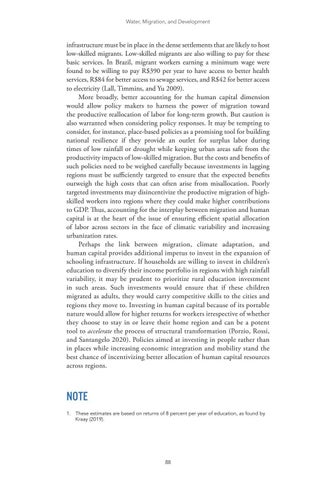Water, Migration, and Development
infrastructure must be in place in the dense settlements that are likely to host low-skilled migrants. Low-skilled migrants are also willing to pay for these basic services. In Brazil, migrant workers earning a minimum wage were found to be willing to pay R$390 per year to have access to better health services, R$84 for better access to sewage services, and R$42 for better access to electricity (Lall, Timmins, and Yu 2009). More broadly, better accounting for the human capital dimension would allow policy makers to harness the power of migration toward the productive reallocation of labor for long-term growth. But caution is also warranted when considering policy responses. It may be tempting to consider, for instance, place-based policies as a promising tool for building national resilience if they provide an outlet for surplus labor during times of low rainfall or drought while keeping urban areas safe from the productivity impacts of low-skilled migration. But the costs and benefits of such policies need to be weighed carefully because investments in lagging regions must be sufficiently targeted to ensure that the expected benefits outweigh the high costs that can often arise from misallocation. Poorly targeted investments may disincentivize the productive migration of highskilled workers into regions where they could make higher contributions to GDP. Thus, accounting for the interplay between migration and human capital is at the heart of the issue of ensuring efficient spatial allocation of labor across sectors in the face of climatic variability and increasing urbanization rates. Perhaps the link between migration, climate adaptation, and human capital provides additional impetus to invest in the expansion of schooling infrastructure. If households are willing to invest in children’s education to diversify their income portfolio in regions with high rainfall variability, it may be prudent to prioritize rural education investment in such areas. Such investments would ensure that if these children migrated as adults, they would carry competitive skills to the cities and regions they move to. Investing in human capital because of its portable nature would allow for higher returns for workers irrespective of whether they choose to stay in or leave their home region and can be a potent tool to accelerate the process of structural transformation (Porzio, Rossi, and Santangelo 2020). Policies aimed at investing in people rather than in places while increasing economic integration and mobility stand the best chance of incentivizing better allocation of human capital resources across regions.
NOTE 1. These estimates are based on returns of 8 percent per year of education, as found by Kraay (2019).
88



